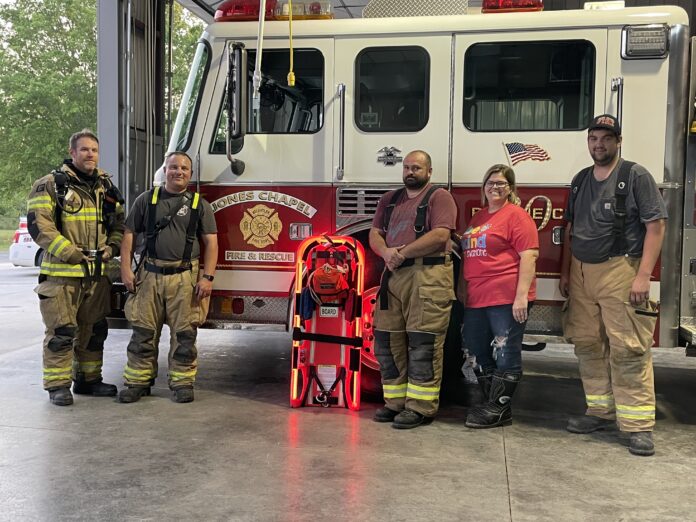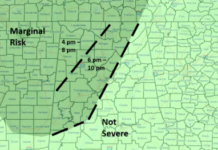
Cullman County is home to more than 83,000 residents. There are two full-time fire departments serving the residents of the city of Cullman (about 16,000) and the residents of the city of Hanceville, (about 3,300). That means approximately 63,000 residents are served by the unpaid men and women who make up the 26 volunteer fire departments (VFDs) throughout the rest of the county, although West Point and Vinemont do have some paid members on staff.
Just like the departments in Cullman and Hanceville, VFDs are dispatched to fires, vehicle crashes, medical calls, weather-related emergencies and other events.
Baileyton VFD Chief Zack McGee and Jones Chapel VFD Chief Clint Thrasher talked to The Tribune recently about the need for more volunteers and how they try to mitigate the shortage of interested recruits.
In addition to full-time jobs and fighting fires in their spare time, volunteer fire fighters attend community events to introduce themselves to their neighbors and help them learn about the services each department offers. These events are also a great way for departments to find individuals who want to become members.
Thrasher described the recruitment process, saying, “We use our social media page as well as word of mouth in an attempt to obtain new members. We also go to several functions in our community. During those events we set up a display and talk to people in the community. Once someone applies, they must pass a background check and drug test. If they pass both of those, then our officers – chiefs, captains, lieutenants, secretary and treasurer – review their application and then the general membership will vote. Sounds like a lot more than it really is.”
Thrasher said his department needs not only fire fighters but also people to answer medical calls.
“People who don’t want to do either, can still assist in other ways such as directing traffic, handing out water at fires and cutting trees from the roadway and other support staff duties,” he said.
McGee’s department at Baileyton handles mostly medical calls. He said he thinks the reason many do not join, or that the station is not able to retain recruits, is because of a lack of interest in attending medical calls.
“We get a decent amount of inquiry, but many lose interest as soon as they find out there is no pay. Or they join and lose interest when they discover that most of the calls are medical. Over 80% of our call volume is medical in nature,” he said.
Many of each stations’ current members have full-time jobs and children. McGee said some members have reached the age where they are not able to be as physically active in department duties. Therefore, more members would help increase the odds that someone would be available to go on most calls.
As for why they think it is a challenge to find new members, McGee stated, “I think time is a key factor. It is difficult to find someone who will give up what little free time they have to respond to calls. The job is also uncompensated, which is counterintuitive for most people. It is simply hard to find a person who is willing and able to perform as a firefighter and/or EMT, as well as do it for free, to be a volunteer. It is necessary to find a person who has a true desire to help others.”
Thrasher added, “People are busy. I hear people say, ‘I’m too busy to join.’ I try to explain that maybe if they join, they could help with a call when no one else can go. Maybe they could go help someone out of the floor, or maybe go direct traffic at a wreck. I often tell people that my wife and I both work full time and have three kids playing sports year-round. But somehow, we both are able to run calls, attend most of the trainings and meeting. We don’t expect members to leave their job or miss important family events. My motto for the new members is ‘Help as much as you can when you can. If you can’t make it, you can’t make it.’”
There is generally not a standardized set of mandatory training at volunteer fire departments. The Baileyton and Jones Chapel stations do not have required training. However, they do encourage as much training as their members can get.
Thrasher stated, “I think training is very important. I am still currently enrolled in training, and I have been in the fire service since 2002. You can’t ever get enough training in my opinion. We don’t have strict requirements on a timeline. We do require some in-house training to drive the vehicles and we train in house on things weekly. For any member willing to become a certified volunteer fire fighter, EMT, etc., we provide that training at no cost to the member and usually provide a vehicle to get to the training if it’s not at our station. The member just has to volunteer their time.”
To be a state certified volunteer firefighter, personnel must attend a 24-hour Emergency Care Provider (ECP) course and a 160-hour Certified Volunteer Firefighter course through the Alabama Fire College. For Emergency Medical Technician (EMT) certification, the course is 180 hours.
“It is difficult to find people who have the time to commit to these courses and still have the time necessary for their jobs and family,” added McGee.
Thrasher said firefighters and medical personnel do not work in any kind of shifts. Each member tries to answer any call that is dispatched if they are available.
“Usually during severe weather several members will man the stations and be ready. We also are trying out a new program by allowing members, usually EMTs, to take home one of our SUVs and one car. Those members respond without having to go to the station and get a rescue truck. This is in an attempt to speed up our response times. This is why sometimes people will see a marked fire department vehicle in someone’s driveway in our community,” he said.
Most volunteer fire departments in the county are in great need of more volunteers. Jones Chapel currently has 19 active members on its roster, eight of which have been in the department for two years or less. Jones Chapel had 401 calls for service in 2021. Its monthly average so far this year is 30 calls per month.
In 2021, Baileyton was dispatched to 698 calls, which averaged to around 58 per month. Of these, only 267 were inside its coverage area, the remainder were calls for mutual aid from other departments.
Social media has become a valuable tool for recruitment. VFDs have used the platforms to gain attention for their departments by posting about recent calls and community events. But, both Thrasher and McGee said current members are their most important assets for gaining recruits.
Thrasher said, “I think our best new tactics are new members who are getting out there shaking the bushes telling their friends about us. It’s a trickle-down effect.”
Thrasher invites people to come by the Jones Chapel department Monday nights to check out the way it operates. Jones Chapel does trainings most Mondays, except for the first Monday of the month, which is a business meeting. Members try to keep the bay doors open so the building feels more inviting to people driving by.
“We want citizens to know that it’s a community fire department,” he said. “People can always just stop by and visit if they see any of us there, no obligation to join. We just enjoy meeting our citizens.”
Copyright 2022 Humble Roots, LLC. All Rights Reserved.



















